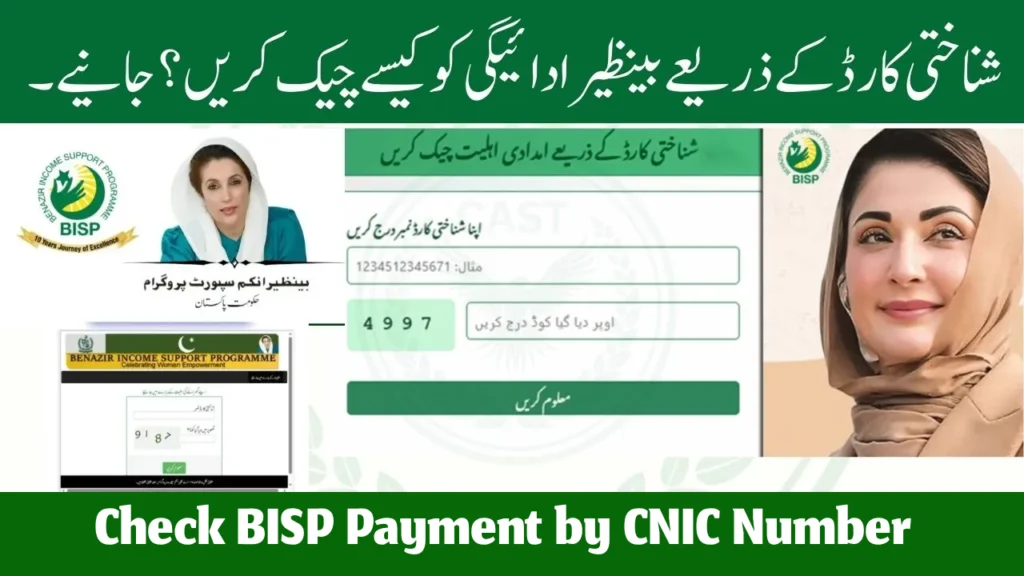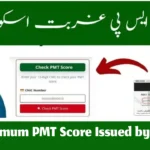
Your Guide to Checking BISP Payments Like a Pro
Hey there! If you’re wondering how to check BISP payment by CNIC number detail tracking system, you’re in the right place. The Benazir Income Support Programme (BISP) is a lifeline for millions of families in Pakistan, helping them cover basic needs like food, healthcare, and education. But let’s be real—figuring out how to track your payment can feel like solving a puzzle sometimes! Don’t worry, though. I’m here to break it down for you in the simplest, friendliest way possible, like we’re chatting over a cup of chai. By the end of this article, you’ll be a pro at checking your BISP payment status using your CNIC (that’s your Computerized National Identity Card, by the way). Plus, I’ll share the latest 2025 updates, tips to avoid common mistakes, and even answer some questions you might have. Ready? Let’s dive in!
What Is BISP, and Why Should You Care?
Before we get to the how-to part, let’s quickly talk about what BISP is. The Benazir Income Support Programme is a government initiative in Pakistan that gives cash to low-income families, especially women-led households, to help them get by. Think of it as a helping hand for those who need it most. Whether it’s paying for groceries, school fees, or medical bills, BISP payments make a big difference.
In 2025, BISP is bigger than ever, supporting over 9 million families with quarterly payments. The best part? You can check if you’re eligible or if your payment is ready using just your CNIC number. No need to run around to offices or wait in long lines—most of it can be done from your phone or computer. Cool, right?
Why Checking Your BISP Payment Matters
Okay, so why bother checking your payment status? Well, here’s the deal:
- Stay in the Loop: Knowing when your payment is coming helps you plan your expenses.
- Avoid Delays: If something’s wrong with your registration, you can fix it before missing out on cash.
- Peace of Mind: No more guessing whether the money’s on its way or not.
- Transparency: BISP’s tracking system makes sure you know exactly what’s happening with your funds.
Plus, with 2025 bringing new updates to the program, staying on top of your payment status is super important. Let’s explore what’s new this year.
Latest BISP Updates for 2025
BISP is always evolving, and 2025 has some exciting changes to make things easier for beneficiaries. Here’s what you need to know:
- Increased Payments: The quarterly payment has jumped from Rs. 10,500 to Rs. 13,500 to help families cope with inflation. More money to cover your needs!
- New Programs: BISP’s Nashonuma and Taleemi Wazaif programs now offer extra support for pregnant women and kids in school.
- Easier Access: More banks, like HBL and Bank Alfalah, are now part of the payment system, so you can withdraw cash from ATMs or designated centers.
- Dynamic Surveys: BISP workers are visiting homes throughout 2025 to update records and include new eligible families. If you’re not registered yet, this is your chance!
- Transgender Inclusion: For the first time, transgender individuals can join the program with relaxed eligibility rules. All you need is a CNIC marking you as transgender.
These updates mean more people can benefit, and checking your payment status is easier than ever. Let’s get to the fun part—how to actually check your BISP payment!
Step-by-Step Guide: How to Check BISP Payment by CNIC
Tracking your BISP payment is super simple, and you’ve got a few options to do it. Whether you’re a tech whiz or someone who prefers old-school methods, there’s a way for you. Here are the three main methods to check your payment using your CNIC number.
Method 1: Check BISP Payment Online
If you’ve got internet access, this is the easiest way to track your payment. Here’s how to do it:
- Visit the Official BISP Portal
Open your browser (on your phone or computer) and go to the official BISP website. It’s user-friendly and works on any device. - Find the Tracking Section
Look for a section that says something like “Check Your Status” or “Eligibility Check.” It’s usually right on the homepage. - Enter Your CNIC Number
Type your 13-digit CNIC number without any dashes or spaces. Double-check to make sure it’s correct! - Complete the Captcha
You’ll see a little box with numbers or a picture puzzle (like “type these digits” or “click the traffic lights”). This is just to prove you’re not a robot. - Hit Submit
Click the green “Submit” or “Check” button, and in a few seconds, you’ll see your payment status. It’ll tell you if you’re eligible, if a payment is pending, or if there’s an issue.
Pro Tip: Bookmark the BISP website so you can check your status anytime without hunting for the link.
Method 2: Check BISP Payment via SMS
No internet? No problem! You can check your payment status by sending a quick text message. Here’s how:
- Open Your Messaging App
Grab your phone and open the app you use for texting. - Type Your CNIC Number
In a new message, type your 13-digit CNIC number (no spaces or dashes). - Send to 8171
Send the message to the number 8171. This is BISP’s official SMS service. - Wait for a Reply
In a minute or two, you’ll get a text back with details about your eligibility or payment status. It might say something like “Your payment of Rs. 13,500 is ready” or “Please visit a BISP office for registration.”
Note: Use the phone number registered with your CNIC for the best results. Also, this service is free, so don’t worry about extra charges!
Method 3: Visit a BISP Office or ATM
If you prefer doing things in person or don’t have a phone/internet, you can check your status the old-fashioned way:
- Find Your Nearest BISP Office
Every tehsil in Pakistan has a BISP office. Ask around or check the BISP website for the closest one. - Bring Your CNIC
Make sure you have your CNIC with you. Staff will use it to check your status in their system. - Ask for Help
Tell the staff you want to check your payment status. They’ll guide you through the process and let you know if your payment is ready or if there’s an issue. - Check via ATM
If you have a BISP card, you can also visit an HBL or Bank Alfalah ATM. Insert your card, enter your PIN, and select the “Balance Inquiry” option to see if your payment has been credited.
Fun Fact: Visiting a BISP office is like going to a busy marketplace—there’s always someone ready to help, but it might take a bit of patience!
Common Mistakes to Avoid When Checking BISP Payments
Alright, now that you know how to check your payment, let’s talk about some slip-ups to avoid. These are super common, but don’t worry—I’ve got your back!
- Typing the Wrong CNIC Number
It’s easy to mix up a digit or two, especially if you’re in a hurry. Always double-check your CNIC number before hitting submit or sending that SMS. - Using an Unregistered Phone Number
For the SMS method, use the phone number linked to your CNIC. If you use a random number, you might not get a reply. - Falling for Scams
BISP will never ask you to send money or share personal details with random callers. If someone texts you claiming to be from BISP and asks for cash, ignore it and report it to the BISP helpline (0800-26477). - Not Updating Your CNIC
If your CNIC has expired or your details have changed (like your address or name), update it with NADRA before checking your BISP status. An outdated CNIC can cause problems. - Ignoring Error Messages
If the portal or SMS says something like “Not Registered” or “Visit a BISP Office,” don’t just shrug it off. Follow up by visiting a BISP center to fix the issue.
By dodging these mistakes, you’ll save yourself a lot of headaches and get your payment info faster.
Benefits of Using the BISP Tracking System
Why is the BISP tracking system so awesome? Let’s break it down:
- It’s Super Convenient: Check your status from home, on your phone, or at an ATM—no need to travel unless you want to.
- Saves Time: No more waiting in long lines or calling multiple offices to get answers.
- Transparent and Fair: The system makes sure only eligible people get payments, so you know the process is legit.
- Empowers You: Knowing your payment status gives you control over your finances and helps you plan better.
- Accessible Everywhere: Whether you’re in a big city or a small village, the SMS and online options work across Pakistan.
Honestly, the tracking system is like having a personal assistant who keeps you updated on your money. Pretty neat, huh?
Troubleshooting: What to Do If You Face Issues
Sometimes, things don’t go as smoothly as we’d like. Maybe the website’s down, or you get a weird error message. Here’s how to handle common problems:
- No Response from SMS
Wait a few minutes and try sending your CNIC to 8171 again. If it still doesn’t work, visit a BISP office or call the helpline at 0800-26477. - Website Shows an Error
If the BISP portal is down or shows “Server Error,” try again later. It could be a temporary glitch. Clearing your browser cache might help too. - “Not Eligible” Message
If you’re told you’re not eligible, it could be due to outdated CNIC details or an incomplete survey. Visit a BISP office with your CNIC and any other documents (like utility bills) to re-register or appeal. - Payment Not Received
If your status says the payment is ready but you haven’t gotten it, check with your bank or ATM. Sometimes payments take a day or two to process. If it’s still missing, contact the BISP helpline. - Biometric Issues
If your fingerprint isn’t working at the ATM or payment center, visit a BISP office. They can update your biometric data or issue a new card.
Don’t stress if you hit a snag—just follow these steps, and you’ll be back on track in no time.
Who Can Benefit from BISP in 2025?
BISP is designed for people who need a little extra help. Here’s a quick look at who qualifies:
- Low-Income Families: If your household earns less than Rs. 25,000 per month, you might be eligible.
- Women-Led Households: BISP prioritizes families where a woman is the main breadwinner.
- Crisis-Affected Families: If you’ve been hit by floods, inflation, or other hardships, BISP can help.
- Transgender Individuals: New rules in 2025 make it easier for transgender people to join.
- Families with Kids or Pregnant Women: Programs like Taleemi Wazaif and Nashonuma offer extra support for education and health.
If you’re not sure if you qualify, check your status using the methods above or visit a BISP office to start the registration process.
How to Register for BISP in 2025
Not signed up for BISP yet? No worries! Here’s how to get started:
- Visit a BISP Tehsil Office
Find the nearest BISP office in your area. Bring your CNIC and any documents like utility bills or proof of income. - Complete the Dynamic Survey
BISP staff will ask you to fill out a form about your financial situation. Be honest—this determines if you’re eligible. - Submit Your Documents
Hand over your CNIC and other papers. The staff will verify everything with NADRA (the national ID authority). - Wait for Confirmation
You’ll get an SMS from 8171 letting you know if you’re approved. If you are, your payments will start soon! - Get a BISP Card
Once approved, you’ll get a BISP debit card to withdraw money from ATMs or payment centers.
The process is straightforward, and BISP offices are set up to make it as easy as possible.
Fun Fact: BISP’s Impact in Numbers
Did you know BISP has helped over 24 million people since it started in 2008? That’s like giving a boost to the population of a small country! In 2025 alone, over 9 million families are getting quarterly payments, and the program keeps growing. It’s not just about money—it’s about empowering people to live better lives.
Conclusion: Stay on Top of Your BISP Payments
Checking your BISP payment by CNIC is like checking your phone for new messages—it’s quick, easy, and keeps you in the know. Whether you use the online portal, send an SMS to 8171, or visit a BISP office, you’ve got plenty of ways to stay updated. With 2025 bringing higher payments and new programs, there’s never been a better time to make sure you’re getting the support you deserve.
So, grab your CNIC, try one of the methods we talked about, and take control of your finances. If you run into any issues, don’t hesitate to reach out to BISP’s helpline or visit an office. You’ve got this! Keep checking your status regularly, and you’ll never miss a payment. Here’s to making life a little easier with BISP!
FAQs: Your BISP Questions Answered
1. Can I check my BISP payment using someone else’s phone?
Yes, but it’s best to use the phone number registered with your CNIC to avoid any mix-ups. Just send your CNIC number to 8171, and you’re good to go!
2. What if I don’t get a reply from 8171 SMS?
Wait a few minutes and try again. If there’s still no response, visit a BISP office or call the helpline at 0800-26477 for help.
3. Is there a fee to check my BISP status?
Nope! Both the online portal and SMS service to 8171 are completely free.
4. What should I do if my payment is delayed?
Check your status online or via SMS first. If it says the payment is ready but you haven’t received it, visit an ATM or BISP office to confirm.
5. Can I use my BISP card at any bank?
Most payments are processed through HBL or Bank Alfalah ATMs and centers. Check with your local BISP office to confirm other options.
6. How do I know if I’m eligible for BISP?
Send your CNIC to 8171 or check the BISP website. If you’re not registered, visit a BISP office to complete the survey and apply.

